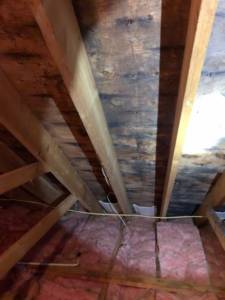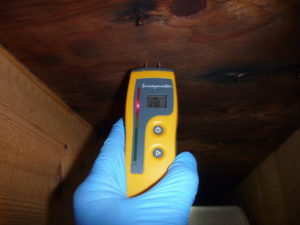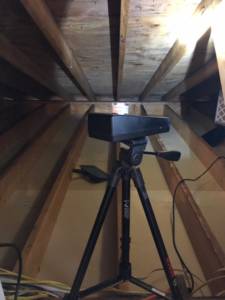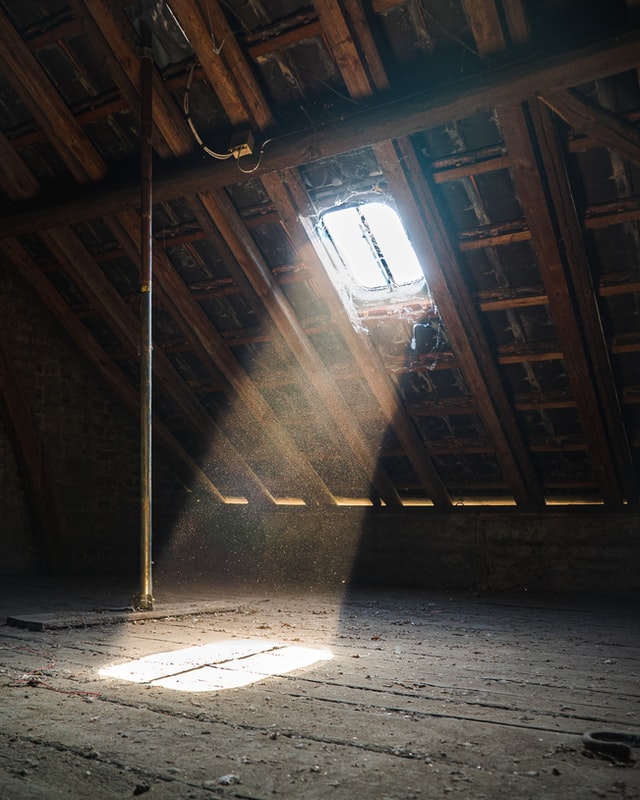We recommend attic mold testing at least every two years. If you’ve never conducted attic mold testing or if it has been a while take a peek up in the attic this week. Are there signs of discoloration on the sheathing or rafters? Is there a musty odor or signs of water staining. It might not be on your spring cleaning list, but it’s important to keep an eye on your attic’s health. Even though your attic is out of sight and out of mind, that doesn’t mean you’re free from any health risks it poses.
Cladosporium Mold Attic SheathingWhen attics harbor moisture, they become breeding grounds for mold and can impact the integrity of your home’s roof and structure. And if left unchecked, the more expensive it can be to remediate and the more your home’s value will suffer.
The best way to detect issues is via attic mold testing. Knowing the type of mold, its source, and its severity will help to determine the most effective remediation so that you and your family can have peace of mind with every breath.
How Mold Can Form in Attics
Mold forms in attics due to several factors. One of the most common is by having fixtures improperly insulated. Heat and moisture can seep into your attic if your ceiling fixtures aren’t properly insulated or sealed. In some homes, the dryer vent discharges into the attic instead of outside. The warm, moist air from the dryer has no way to escape, which means it lingers in your attic and can cause serious moisture problems.

The same issues happen with bathroom and kitchen vents. Many people use a vent in the bathroom to reduce moisture, but this damp air is sent to the attic, where it has no way to exit your home. Kitchens and bathrooms produce a lot of moist air, and if you use a vent to remove it, the air should be directed outside.
Roof leaks, even minor ones, are deadly for your attic’s health. Many attics simply don’t have the proper ventilation it needs to remove moisture. Mismatched or ineffective vents may help to trap more moisture than they remove, which can make mold and mildew worse.
Why is Attic Mold Dangerous?
No homeowner wants mold invading their home, and for good reason. Mold in your attic can degrade the sheathing and roof structure. And seeing as how your roof is your home’s first defense from the elements, it’s important to keep it intact and functional.
Mold growth can also spread to other areas of your home and contaminate your home’s air quality. While it’s rare for attic mold to cause serious air quality issues, the spores can infiltrate your home via the HVAC system. And don’t forget that each time you enter your attic, you’re putting your health at risk.

On the monetary side, mold in the attic could send the value of your home into a tailspin. If you’re trying to sell your home, a home inspection will reveal any mold damage, which could scare off potential buyers. Or, buyers will ask that you pay for mold remediation in order to move forward with the sale.
Mold only gets worse if it’s left untreated. And as it grows, it gets more expensive to treat.
Visually speaking, attic mold can look like spots or stains on the attic walls, particularly black or white spots. These stains may appear to grow over time as the mold spreads. If you see spots on your attic walls or you detect a musty smell (commonly caused from stale air not being able to move outside), then it’s a good idea to have your attic tested for mold to see the extent of the problem.
Homeowners Can Prevent Attic Mold
The best (and least expensive) defense about attic mold is prevention. Attic mold is preventable, but even diligent homeowners may find themselves facing mold issues at some point. To give yourself the best chance of keeping mold out of your attic, insulation and venting should be top priorities. Insulation on the attic walls and floors can prevent warm, moist air from mixing with cooler attic air. Check to see if you have insulation around heating ducts, skylights, and the attic access panel.
Mold Testing Laws and What Consumers Need To Know
All of your household vents (bathroom, kitchen, and dryer vents) should direct to the outside. This keeps excess moisture out of your attic that could cause mold. If you’re not sure if these vents go to the attic, look for pipes in your attic that are cut off before they reach the roof of your home. If you don’t see any pipes, turn on the vent and follow the sound.
Also, the ventilation panels in your attic should be consistent and clear of debris. Check each vent to ensure they’re clean and not blocked by trees or other outdoor obstructions. Some moisture in the attic is inevitable, so it’s critical to keep air moving through the space and prevent moisture from lingering.
Bottom Line: When Do You Really Need Attic Mold Testing?
Attic mold can be a serious issue, both to your health and to the value and integrity of your home. If you spot mold in your attic, it’s prudent to get your mold tested before moving forward with removal or remediation.
Poor Indoor Air Quality Causes Headaches
Mold testing can help to determine the type of mold and the severity of the issue so that you can choose the proper course of action. You wouldn’t want to spend a fortune on mold removal only to have it return because you didn’t find the source of the mold.

Reach out to Indoor Doctor today to schedule mold testing or for more information.





